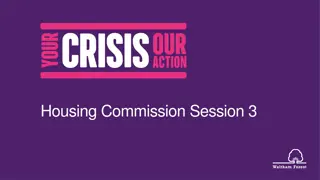Guide to Independent Living for Individuals with Developmental Disabilities
Empowering individuals with developmental disabilities to move towards independent housing, this guide addresses essential aspects such as choosing a living environment, support systems needed, and eligibility criteria for housing services. It emphasizes the importance of personal preferences in determining living arrangements and highlights the various forms of assistance available to enhance quality of life.
Download Presentation

Please find below an Image/Link to download the presentation.
The content on the website is provided AS IS for your information and personal use only. It may not be sold, licensed, or shared on other websites without obtaining consent from the author.If you encounter any issues during the download, it is possible that the publisher has removed the file from their server.
You are allowed to download the files provided on this website for personal or commercial use, subject to the condition that they are used lawfully. All files are the property of their respective owners.
The content on the website is provided AS IS for your information and personal use only. It may not be sold, licensed, or shared on other websites without obtaining consent from the author.
E N D
Presentation Transcript
Making the Move to Independent Housing: Ready, Set, Rent! Department of Behavioral Health & Developmental Services Housing Team DBHDS Vision: A life of possibilities for all Virginians
Supporting an Integrated Life Integrated Life Definition A long standing vision for Virginia includes having a system of supports and services where individuals with disabilities have opportunities for freedom, equality, and the opportunity to participate fully in public life to the extent that people define their own integrated life based on what is important to them. Slide 2
How do you want to live? Where we want to live and who we live with is often decided by what we like to do. Do you work attend school, or a day program? Do you belong to a church, club, gym or hobby group? How do you get around? Do you drive, use the bus system, or do you get rides from friends, family or staff? Are you a homebody or do you like to go out and do things every free minute you have? Or do you like a little bit of both? Do you like to cook, decorate and do housekeeping or do you only do those things because you have to? How do you spend money? Do you have help with your money? Do you need help with your money? Are you really good with money and can pay all of your bills? Slide 3
What kind of help do you need? We all need help! Banks help us with our money an paying bills Stores have shopping apps to buy our food and pick it up Vacuums help us keep our houses clean Friends, family help us keep busy visiting and going places together. Gyms help us stay healthy Places of worship helps us find volunteer things to do for others Hobbies keep our minds and hands active Jobs give us money to pay bills, have places to live and buy things. Doctors and nurses help us when we don t feel well Who or what else help us?
Who is in the Settlement Agreement Population for Housing? People with developmental disabilities who: Are age 18 or older; AND Are in ONE of these categories: Individuals that meet the Virginia Individual Developmental Disability Eligibility Survey for a Medicaid Developmental Disabilities (DD) Waiver and currently live in an Intermediate care facility, training center or hospital. receiving Medicaid DD Waiver Services (e.g., group home, in- home support, personal assistance, companion services, integrated day or employment services, etc.); Currently on a waitlist for Medicaid DD Waiver Services Slide 5
What are the Core Features of Integrated Independent Housing? Integrated Independent Housing has 7 core features: 1. Individual does not reside with a parent, grandparent or guardian 2. Individual can live in housing types that anyone without a disability lives in, based on income 3. Individual has social, religious, educational and personal opportunities to fully participate in community life or not 4. Housing is affordable (individual pays no more than 30% of his/her adjusted gross income) 5. Housing is accessible (barrier free) 6. Housing is leased or owned by the individual 7. Housing is not contingent upon participation in services (and vice versa) Slide 6
People that can provide support Who can help me? The people we most often call on for help are friends and family. Next door neighbors, roommates, church members, an coworkers also help us sometimes when we put out the call for help. These people are unpaid support, natural support. Doctors, nurses, teachers, plumbers, electricians, maintenance workers, paid staff, live in aides, physical therapists, counselors, mechanics. These are people that we pay either with our own money, insurance or some other source of money to help us. These people are paid to do things we can t do ourselves. Sometimes they are called service providers or paid providers.
Housing Resources in VA for the Settlement Agreement Population Housing Choice Voucher Program (HCVP) State Rental Assistance Program (SRAP) Low Income Housing Tax Credit Properties lease preference DBHDS Flexible Funding
Housing Choice Voucher Program (HCVP) Housing Choice Voucher Program Individuals can apply for HCV s in a number of places Some Department of Social Services (when there waitlist is open) Some private non profits (When their waitlist is open) Local Public Housing Authorities (When their waitlist is open) DBHDS has a been provided with a number of Housing Choice Vouchers from several PHA s as well as Virginia Housing. These are available through the same process that will be outlined below. They are available to the same Target Population as State Rental Assistance.
State Rental Assistance Program (SRAP) DBHDS created the State Rental Assistance Program in October 2016. This program mirrors key elements of the HCV Program. The program is only open to individuals in the Settlement Agreement population. Under this program, individuals: Lease their own units Fair Market Rent is used as payment standard Contribute 30%-40% of adjusted gross monthly income towards rent with a utility allowance Get supports from a variety of sources which are provided separately from their housing Cannot live with parent, grandparent or guardian Slide 12
Low Income Housing Tax Credit Properties (LIHTC) Lease Preference LIHTC program offers affordable housing to low/moderate income households rents are set for residents in certain income ranges rents may be higher than what a single person on SSI/DI can afford Some LIHTC properties have a preference for Settlement Agreement applicants. They move to the top of the waitlists & apply for specific units. Rent assistance is attached to some apartments. Other apartments have no rent assistance. HCVP/SRAP participants can use it to help pay rent in unassisted apartments. Slide 13
Referral Process for Rental Assistance (HCVP, SRAP & LIHTC) Individuals must be referred to DBHDS for Rental Assistance by: DD Support Coordinators/Case Managers Individuals should be referred when they: have made an informed decision to lease and live in rental housing; understand that that cannot live with a parent, grandparent or guardian; are or can be ready to move within 60-120 days of being referred and/or approved for a rental assistance; and have or will have adequate waiver, non-waiver and natural supports in place to obtain and maintain housing. Slide 14
Referral Process DBHDS checks referral for completeness and verifies target population eligibility DBHDS forwards eligible referrals to local subsidy administrator based on availability SC submits DBHDS Housing Referral to DBHDS Slide 15
Referral Process Individual must complete eligibility process within 45 days will need birth certificate, state issued picture ID, SSI card and proof of income Once approved for participation in the rental assistance program, voucher/certificate is issued to begin searching for housing Local subsidy administrator contacts individual and SC for eligibility review appointment Slide 16
DBHDS Flexible Funding Provides financial assistance to help eligible individuals cover: Expenses to get into housing (up to $5000) Includes application fees, security deposits, utility deposits, temporary rent, assistive technology/environmental modifications not covered by Waiver or other sources, furniture, household supplies, moving expenses, temporary supports and other expenses. Expenses to maintain your housing (up to $5000) Includes emergency rent and utility payments, unit repairs, pest extermination, special cleanings, temporary relocation, and other expenses. Slide 17
DBHDS Flexible Funding Criteria Flexible Funding is for a goods or service that an individual needs in order to move into or maintain independent housing. Flexible Funding has (4) approval criteria: 1. The individual could not move into or maintain occupancy of the unit without the good or service. 2. The good or service is essential for the person s health and safety in the home. 3. The household item or service is essential for the person to maintain lease compliance. 4. The good or service is essential to the person s ability to function in and/or use his/her housing. Slide 18
DBHDS Flexible Funding Criteria Flexible Funding is NOT for a good or service that is not deemed needed in order to move into or maintain independent housing. Examples of non-approvable Flexible Funding expenses: 1. Items that are primarily for the purpose of entertainment or recreation. 2. Requests for multiple sets of a particular item, unless it there is a health and safety need or a lease compliance requirement. 3. Goods or services that can be fully funded by another funding source such as Transition Services, Waiver Environmental Modifications, VHDA Rental Unit Accessibility Modification Program. 4. Goods or services that are primarily for the benefit of a housing or service provider, not the eligible individual. Slide 19
DBHDS Flexible Funding Individuals must be referred by their DD Support Coordinator/Case Manager to be considered for Flexible Funding. Flexible Funding is administered by certain CSBs within five regions across the state Flexible Funding is payable to 3rd party vendors via invoice and on a reimbursement basis with receipts; no upfront payments are made. Slide 20
Planning for Integrated, Independent Housing Housing Readiness Assessment & Housing Action Plan Independent Housing Resources & Tools Case Studies Slide 21
Independent Housing Planning Housing Readiness Assessment This tool helps Support Coordinators to assess an individual s readiness for independent housing, determines eligibility for various housing resources and helps in the development of a Housing Action Plan. Housing Action Plan This tool helps Support Coordinators work out and coordinate the details, barriers and needed supports identified in the Housing Readiness Assessment. It also sets goals and divides chores among the team members that are assisting an adult with independent housing. Slide 22
Independent Housing Resources & Tools Fair Market Rents https://www.vhda.com/BusinessPartners/HCVPAgents/Pages/FederalFairMarketRents.aspx Household Spending Plan http://www.dbhds.virginia.gov/assets/Housing/Resources/household-spending-plan.pdf Moving Expenses Budget http://www.dbhds.virginia.gov/developmental-services/housing/resources-for-support- coordinators-and-case-managers Plan to Maintain Stable Housing http://www.dbhds.virginia.gov/assets/Housing/Resources/plan-to-maintain-stable- housing.pdf Housing Choice Voucher Waitlists https://affordablehousingonline.com/sign-up Slide 23
Case Studies Meet Josh! Consumer Directed Supports, Accessibility & Rent Assistance Meet Ryan! Apartment with State Rental Assistance and Live-in Aide
Questions? Slide 25























